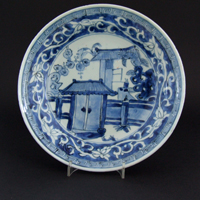
An Inscribed Transitional Porcelain Dish Decorated in Blue and White, Ming Dynasty, Tianqi Period 1621 – 1627
A rare inscribed Ming Blue and White Porcelain dish, Transitional Period, Tianqi 1621-1627.
The central scene shows three geese in the foreground with a fourth goose flying above them, next to it is a four character inscription which can be translated as “May Your Name be Inscribed on the Wall of the Wild Goose Pagoda in Chang`An”. The promontory in the distance shows a pagoda near another building. The scene below, which is upside down, has another four line verse that give the impression of a reflection of the pagoda above. This can loosely be translated as “May You Enjoy the Imperial Spring Banquet in the Apricot Grove“. The flowering plant next to this inscription is apricot with three swallows flying above. The indented cavetto is painted with a scrolling lotus against a blue ground. The outer border is of Greek key against a pale blue ground.
SOLD
- Condition
- In excellent condition, the rim has the type of fritting associated with late Ming porcelain for the Japanese porcelain. What might look like a chip to the rim at 8 o'clock is a firing fault.
- Size
- Diameter : 21.5 cm (8 1/2 inches)
- Provenance
- N/A
- Stock number
- 24674
- References
- A dish of this design but with a somewhat different arrangement is illustrated in the book by the late Sir Michael Butler : Late Ming, Chinese Porcelain from the Butler Family Collections (Sir Michael Butler, Museum d`Histoire et d`Art, Luxembourg, 2008. ISBN 978-2-87985-029-0) page 67. A Transitional porcelain was sold by R and G McPherson, stock number 24007.
Information
The first inscription "May Your Name be Inscribed on the Wall of the Wild Goose Pagoda in Chang`An" relates to a custom started in the Tang Dynasty (618-907). Successful candidates for the highest level of the Jinshi civil service examination had their names inscribed on the wall of the Wild Goose Pagoda in the old Tang capital Chang`an. The second inscription "May You Enjoy the Imperial Spring Banquet in the Apricot Grove" refers to the banquet held near the Wild Goose Pagoda. This inscription is reinforced through a rebus involving spring swallows and apricot blossom. This information comes from the book mentioned below by the late Sir Michael Butler, a man who has totally changed the way we see porcelain from the Transitional period. He will be very much missed.
Ko-Sometsuke :
Ko-Sometsuke, meaning `Old Blue and White` is a term used to describe Chinese blue and white porcelain made for Japan. This late Ming porcelain was made from the Wanli period (1573-1620) and ended in the Chongzhen period (1628-1644), the main period of production being the 1620`2 and 1630`s. The porcelain objects produced were made especially for the Japanese market, both the shapes and the designs were tailored to Japanese taste, the production process too allowed for Japanese aesthetics to be included in the finished object. Its seams firing faults were added, repaired tears in the leather-hard body were too frequent to not, in some cases, be deliberate. These imperfections as well as the fritting Mushikui (insect-nibbled) rims and kiln grit on the footrims all added to the Japanese aesthetic. The shapes created were often expressly made for the Japanese tea ceremony meal, the Kaiseki, small dishes for serving food at the tea ceremony are the most commonly encountered form. Designs, presumably taken from Japanese drawings sent to China, are very varied, often using large amount of the white porcelain contrasting well with the asymmetry of the design.
A Transitional Blue and White Porcelain Dish with the same border design.
Previously sold by R and G McPherson Antiques





